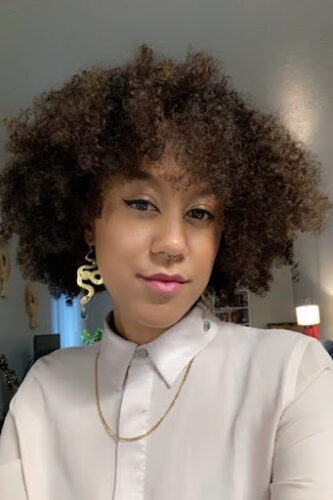On the Art of Writing YA Horror

Writing an unforgettable YA Horror novel takes more than just telling a scary story. Use craft tools like sensory details and character agency to make your book stand out.
By Alexis Powell (WCYA ’24)
May 14th, 2025
Horror is a genre rife with possibility.
It combats social norms, pushes boundaries, and explores the dark depths of the human psyche.
It’s no wonder so many people are drawn to writing YA horror. Young Adult horror is special because teenage protagonists are in high stakes, do-or-die situations without the help of adults guiding their every move. Although gore isn’t necessary for horror, YA horror is void of explicit content, challenging writers to find clever ways to scare their audience.
So how do you write a YA horror novel that will make your readers sleep with the lights on?
Use the following four craft tools to create horror that will keep your readers up at night:
- Increase sensory details
- Build atmosphere
- Ensure character agency
- Explore the unknown
Wake Up and Smell the Rotting Corpse: Sensory Details
Terror is a sensory experience. What is felt, smelt, heard, tasted, and seen communicates to our brains whether something is threatening or not and if we should be afraid. That’s true in real life and in the books we read.
Writer Sydney Stevic said this about the psychology of horror:
“When we read a scary story, our brains react as if the danger is real, releasing adrenaline and other stress hormones that put us on high alert.”
But how do you use that to your advantage?
When your character is moving through a scene, think about what sensory input they would be receiving. If they’re traveling through a dark wood, what would rotted bark feel like to the touch? What sound does a large monster make when lumbering through dense trees?
Sensory input makes readers active participants in the reality you’ve created.
In House of Hollow by Krystal Sutherland, when two characters enter an apartment and discover a dead body, the first thing they notice upon opening the door is “The wet, heavy stench of fermented shit undercut with a cloying sweetness.”
The sensory detail of smell draws the reader into the scene and sets them up for what they will witness next: a decaying body shoved in a closet.
The body is described as “bruised and bloated” with “waxy white flowers sprouting from his mouth, his nose, and softening remains of his eyeballs. Flowers growing rabid from the gash in his skin, their roots red-black and dead blood. Something moved at the back of his throat, behind his broken teeth.”
Vivid sensory details of sight and smell compel the reader to experience the horror of the moment and to feel for themselves what it would be like to be in that room with a rotting corpse.

Crafting an unforgettable atmosphere is a key element of writing YA horror stories.
The Evocation of Place: Atmosphere
Atmosphere is the feeling ascribed to your piece, and for horror writing, the desired feeling is generally eeriness, unease, or fear.
Author and Senior Lecturer at the University of South Australia, Saige Walton, spoke about atmosphere in their article “Air, Atmosphere, Environment: Film Mood, Folk Horror and The VVitch”.
They described atmosphere as something which can be “felt at the level of the senses but cannot be psychically grasped (like a passing breeze, a perfume, or an aroma).”
This intangibility can make atmosphere a fairly nebulous craft element. So here’s what you can do to nail it:
Narrow your focus by picking one thing you wish to create a mood around.
Setting, for instance, is a great place to start to build atmosphere. Hone in on the specific details of that location thinking about what elements could influence the mood.
As an example, What Stalks Among Us, a YA Horror by Sarah Hollowell, takes place in a giant cornfield and uses atmosphere to create an unnerving tone to the space. Cornfields are already spooky locations. They’re easy to get lost in, and they set up a natural barrier between a protagonist and whatever it is that hunts them. A character is constantly one wrong turn away from taking a dirt nap.
But just because a setting in itself can be scary, work still needs to be done to create an atmosphere. What is the energy of the cornfield location that influences the mood of that space?
- The cornfield maze in What Stalks Among Us isn’t supposed to exist. Cornfields are for fall. This cornfield shows up miraculously in early May. It feels out of place.
- The maze has control over light; it’s incredibly dark when it desires and allows light in to refract reality when need be. How well characters can see is unpredictable.
- The air pressure surrounding the maze threatens rain. It’s foreboding.
These details help make the maze go from a mere setting to a place with a spine-chilling feeling to it.
Atmosphere creates an immersive experience for your reader and can effectively put them on edge.
Don’t Go Down There… Or Do: Character Agency
What is character agency anyway? Author Chuck Wendig defines character agency as:
“… a demonstration of the character’s ability to make decisions and affect the story. This character has motivations all her own. She is active more than she is reactive. She pushes on the plot more than the plot pushes on her. Even better, the plot exists as a direct result of the character’s actions.”
In What the Woods Took by Courtney Gould, the protagonist, Devin, is woken in the middle of the night as men force her from her bed so she can attend a wilderness therapy program. Devin doesn’t go quietly. She screams, kicks, and punches the entire way, and when she meets another kid in her situation who sits idly by, she snaps at him that he should be doing something because, quote:
“‘Counting on someone else to help is like waiting to pay your bills until you’ve won the lottery. If you don’t figure out how to take care of yourself without it, you’ve already lost.’”
Fighting for yourself because others might not is Devin’s way of life, and as a result, she feels contempt for those that don’t make decisions for themselves.
Devin has character agency. Despite the fact that she’s a teenager and many decisions in a young adult’s life are decided for them (what they do, where they go, what their rights are), Devin maintains that she always has the right to choose. Even in a seemingly hopeless situation.
In all manners of storytelling, character agency is important, but in YA horror where teens make choices that could potentially end their life, character agency is crucial.
So give them the ability to choose. Even if they choose wrong and end up facing the business end of a chainsaw, at least they got to determine their own fate.

At VCFA, experienced faculty give lectures on a wide range of topics, including writing YA horror. Pictured: Faculty member Evan Griffin.
Traveling Through the Dark: The Unknown
A 2016 study of fundamental fears discovered that the fear of the unknown is innate in humans.
It requires no learning, and the resulting response to uncertain stimuli causes “increasing heart rate variability and activation of the amygdala and ventromedial prefrontal cortex,” areas in the brain that are responsible for emotional regulation, fear processing, and decision-making.
Ultimately, the less we know, the more fearful we are.
But what does that mean for writing Young Adult horror?
Let’s look at What the Woods Took again. When the group of teenagers lost in the woods are attacked by creatures, one of the teens, Ollie, tries to recollect to a friend what happened to him.
Ollie says that he’s:
“‘Trying not to think about the shape-shifting dad-shaped monster that tried to…’ He tries to finish his sentence, to say what the thing actually wanted from him. But it’s a formless danger, a knowledge that the thing could’ve killed him but no distinct understanding of how or why.”
The horror element here is the threat of the unknown–something our brains are hard-wired to fear.
Now, as with all things, you should work with intentionality when crafting an unknown element into your work.
Withholding too much information can result in reader frustration. Withholding not enough information can be like turning the lights on during a scary movie. It may not be integral to the plot to know where an ancient evil hailed from, but a character might need to figure out just enough about the antagonist’s weakness to stop them and survive.
One of the most terrifying quotes in horror movie history (if you ask me) is in the movie THE STRANGERS when one of the masked antagonists terrorizing a couple says “because you were home” in a response to “why are you doing this?”
It’s scary because the reason isn’t really a reason at all. Humans want reason. We want an explanation. We want to know.
Denying (total) explanation and forcing readers to sit in the (metaphorical) darkness can add an edge to your YA horror.
YA Horror Novels Matter
YA horror allows teens to explore dark topics in a safe manner. It builds emotional resilience and tells kids that they have the ability to survive the dark. Teens nowadays need it now more than ever so the more writers interested in writing YA horror, the better.
Sensory details, atmosphere, character agency, and the unknown will aid in improving your YA horror, but this article just scraped the surface of what you can do. There are many, many more elements of craft that can help you along your writing journey.
If you want to better hone your writing skills, consider a degree in Writing for Children & Young Adults from VCFA where you can learn from expert storytellers, gain a close-knit community, and grow in your craft! Spooky or otherwise.

Alexis Powell
(WCYA '24) alexispowellstories.comAlexis Powell is a bookseller and storyteller with an MFA in Writing for Children and Young Adults from Vermont College of Fine Arts. She works at The King’s English Bookshop in Salt Lake City and is Co-Executive Editor of the literary magazine We Are the Quiet Ones. She also holds a BS in Biology from San Diego State University, and earned a Certificate in Publishing from the Denver Publishing Institute. Alexis loves animals (especially her adorable ball python Sycamore), cartoons, graveyard strolling, drawing, and movie marathons.
Related Posts
- Artist Grants: What They Are, Where to Find Them, and How to Apply Aug 01, 2025
- How to Get Your Art into a Gallery Jun 09, 2025
- Beyond Quotation Marks: How to Write Dynamic Dialogue Jun 02, 2025

